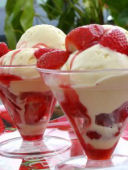
Purpose
To show how air bubbles can slow the penetration of hot air, resulting in a delicious baked ice-cream cookie treat!
Additional information
Have you ever heard of a Baked Alaska? No, it's not the term used for an Alaskan citizen who's been out in the sun too long. A Baked Alaska is a desert made from ice cream, sponge cake, and meringue. The desert is cooked in an extremely hot oven so that the meringue firms, but the ice cream does not melt. The name "Baked Alaska" was first coined in 1876 to honor the acquisition of the American territory and is also known by the names glace au four, omelette à la norvégienne, and Norwegian omelette.
Sponsored Links
Required materials
- 3 or 4 large eggs
- Vanilla ice cream
- 1 large cookie
- 1/2 cup of sugar
- Large mixing bowl
- Whisk or fork
- Ice cream scoop or spoon
- Cookie sheet
- Aluminum foil
- Oven
Estimated Experiment Time
About 20 minutes to set-up, and 5-8 minutes for the ice cream to bake
Step-By-Step Procedure
- 1. Extract the egg whites from the eggs. This can be tricky if you haven't separated egg whites before. To do this, lightly crack the eggs on the edge of your mixing bowl. Turn the egg upward and open the top so that the egg contents remain in the bottom-half of the shell. Hover the shells above the bowl and slowly pour the contents of the bottom-half of the egg into the empty top-half, allowing the egg whites to fall into the bowl, but keeping the yolk in-tact. Keep doing this until you've extracted as much of the egg whites as possible.
- 2. Repeat step #1 for all eggs.
- 3. Use your whisk or fork to beat the egg-whites in the bowl, slowly adding in the sugar as you mix. Keep beating the egg whites and sugar until you have a glossy looking mixture.
- 4. Pre-heat your oven to 500 degrees
- 5. Line your cookie-sheet with the aluminum foil so that it covers the entire surface
- 6. Place your cookie on the center of the foil-lined cookie sheet
- 7. Take a big scoop of Ice Cream that is about the circumference of the cookie and place is in the egg white mixture. Make sure the ice cream is completely covered and submerged.
- 8. Take the ice cream from the mixture and place it on the cookie
- 9. When the oven is pre-heated, place the cookie sheet on the bottom rack
- 10. Bake the ice cream cookie until the ice cream starts to turn a golden brown, about 5 minutes.
- 11. Remove the ice cream cookie from the oven and allow a few minutes to cool.
- 12. The ice cream hasn't melted! Eat and enjoy!
Note
The oven will be HOT! Please get the help of an adult (and permission) before using the oven.
If you find the process of separating the egg whites to be too difficult, you can instead opt to purchase a container of pure egg whites from your local grocery store.
If you want to make some baked ice-cream cookies for your friends, try to avoid making them all at one time. Instead, just repeat the step-by-step procedures for each baked ice-cream treat you want to make.
Observation
Why do you think the ice cream didn't melt? What if you used a mixture other than sugar and egg whites? Would it have the same effect? Do you think the type of ice cream used makes a difference? What if we used chocolate rather than vanilla?
Result
So, why didn't the ice cream melt when it was in a 500 degree oven? The secret is in the mixture! When you beat the egg whites with the sugar, you created lots and lots of tiny air bubbles that were trapped within the foam. When the ice cream was submerged in this mixture, the foam formed a protective barrier. This barrier of tiny bubbles slowed the advance of hot air and prevented it from penetrating to the ice cream. The result is a golden-brown and delicious ice cream treat that wasn't melted under the heat of the oven!
Sponsored Links
Take a moment to visit our table of Periodic Elements page where you can get an in-depth view of all the elements,
complete with the industry first side-by-side element comparisons!